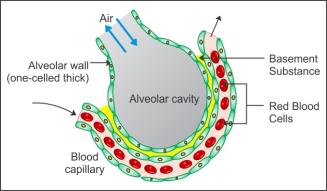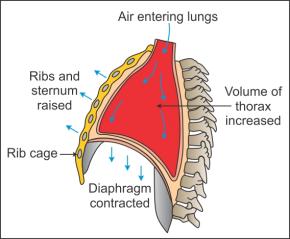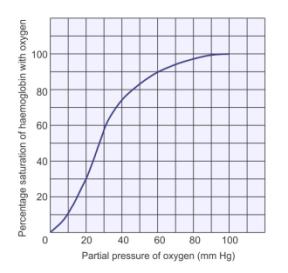Class 11-science NCERT Solutions Biology Chapter 14 - Breathing And Exchange Of Gases
Breathing And Exchange Of Gases Exercise 192
Solution 1
- The maximum volume of air a person can breathe in after a forced expiration is called vital capacity.
- The vital capacity represents the maximum amount of air which can be renewed in the respiratory system in a single respiration.
- The more amount of air inhaled indicates the maximum amount of oxygen available for the oxidation of glucose, and thus more energy becomes available for the body.
Solution 2
- The volume of air which remains in the lungs after a normal expiration is called functional residual capacity (FRC).
- FRC is the sum of expiratory reserve volume (ERV) + residual volume (RV).
- Expiratory reserve volume (ERV): It is the additional volume of air a person can expire by a forced expiration. It is 1000–1100 ml.
- Residual volume (RV): The volume of air which remains in the lungs after a forced expiration. It is 1100–1200 ml

Solution 3
- The structure of alveoli is specially made for the diffusion of gases.
- The total thickness of the alveolar membrane is lesser than a millimetre.
- The outer surface of the membrane is in close contact with the network of blood capillaries.

- The alveolar membrane and the endothelial membrane of blood capillaries are separated by a very thin basement substance.
- Because the barrier between the alveoli and capillaries is very thin, it allows easy diffusion of gases.
- Such a structure is not found in any other part of the respiratory system.
- Hence, the diffusion of gases occurs in the alveolar region and not in the other parts of the respiratory system.
- Also, the alveolar air which comes in close contact with the blood capillaries has high pO2 and low pCO2 which facilitates the diffusion of gases.
Solution 4
Transport of carbon dioxide:
- Carbon dioxide is released in the blood by a more active tissue than a less active tissue.
- Each 100 ml of blood receives on an average 3.7 ml of carbon dioxide from tissues.
- CO2is carried by the blood in three forms:
- As a simple solution:
- About 5–10% of CO2 of the total blood dissolves in plasma and is carried as a simple physical solution.
- As bicarbonate ions:
- At the tissue site, the partial pressure of CO2 is high because of catabolism.
-
CO2 diffuses into the blood and reacts with water to form carbonic acid. The reaction takes place in the presence of the enzyme carbonic anhydrase.

-
Carbonic acid dissociates into bicarbonate and H+ ions.
-
Some amount of bicarbonate ions is used in maintaining the pH of blood, and hydrogen ions are taken up by proteins.
-
The rest of the bicarbonate ions are carried by plasma.
- As carbamino-haemoglobin:
- When the partial pressure of carbon dioxide is high and the partial pressure of oxygen is low in tissues, CO2 combines loosely with the globin part of the reduced haemoglobin to form carbamino-haemoglobin.

- When pO2 is high and pCO2 is low in alveoli, CO2 dissociates from carbamino-haemoglobin; hence, CO2 bound to haemoglobin is released in the alveoli.
- When the partial pressure of carbon dioxide is high and the partial pressure of oxygen is low in tissues, CO2 combines loosely with the globin part of the reduced haemoglobin to form carbamino-haemoglobin.
Solution 5
(ii) pO2 higher, pCO2 lesser
pO2 will be higher and pCO2 will be lower in the atmosphere.
Every gas in a mixture of gases exerts a pressure called partial pressure. Gases always diffuse across the pressure gradient. When pO2 is higher in the atmosphere, oxygen can easily enter the lungs. Similarly, CO2 can diffuse out of the body only if pCO2 is lower in the atmosphere.
Solution 6
- Inspiration is the process by which fresh air enters the lungs.

- It occurs when the pressure inside the lungs, i.e. intrapulmonary pressure is lesser than the atmospheric pressure.
- Inspiratory muscles, i.e. muscles of the diaphragm, external intercostal muscles and abdominal muscles make inspiration possible.
- Muscles of the diaphragm contract and pull the diaphragm down towards the abdominal cavity making it flat.
- This results in an increase in the thoracic cavity vertically in the antero-posterior direction.
- The external intercostal muscles contract and lift up the ribs and sternum. This results in the expansion of the thoracic chamber dorso-ventrally.
- The overall increase in the thoracic volume causes an increase in the pulmonary volume.
- The increase in the pulmonary volume decreases the pressure inside the lungs, and the atmospheric pressure forces air from the outside to move into the lungs.
- Abdominal muscles relax to compress the abdominal organs which increase the strength of inspiration.
- The passage of air during inspiration is as follows:
External nares → Nasal cavities → Internal nares → Pharynx → Glottis →Larynx → Trachea → Bronchi → Bronchioles → Alveolar ducts → Alveoli
Solution 7
Regulation of Respiration:
- Human beings have the capability to maintain and moderate their respiratory rhythm to suit the demands of the body tissues.
- The respiratory rhythm centre present in the medulla oblongata is responsible for the regulation of respiratory rhythm.
- The inspiration respiratory rhythm centre controls the normal rhythm of respiration.
- One respiratory cycle is of 5 seconds—2 seconds for inspiration and 3 seconds for expiration.
- The expiration respiratory rhythm centre is dormant during normal respiration, but it controls the powerful contraction of the intercostal and abdominal muscles during deep breathing.
- The pneumotaxic centre present in the pons regulates or moderates the functions of the respiratory rhythm centre.
- A neural signal from the pneumotaxic centre can reduce the duration of inspiration and hence alter the respiratory rate.
- A chemosensitive area is located adjacent to the rhythm centre.
- This area is highly sensitive to CO2 and hydrogen ions.
- Increase in CO2 and hydrogen ions activates the chemosensitive area.
- Activation of the chemosensitive area signals the rhythm centre to adjust the respiratory process by which CO2 and H+ ions are eliminated.
- Receptors present in the aortic arch recognise changes in CO2 and H+ ion concentration and send signals to the rhythm centre for remedial actions.
- The role of oxygen in the regulation of respiratory rhythm is insignificant.
Solution 8
- pCO2 plays an important role in oxygen transport.
- In the alveoli, because of low pCO2, oxygen binds with haemoglobin resulting in the formation of oxyhaemoglobin.
- In tissues, high pCO2 facilitates the dissociation of oxyhaemoglobin.
- O2 gets bound to haemoglobin at the lung surface where pCO2 is low and dissociates at the tissues where pCO2 is high.
Solution 9
- When a person goes up the hill, the altitude increases.
- At the higher altitude, the concentration of atmospheric oxygen becomes lesser, i.e. the partial pressure of oxygen decreases.
- This increases the demand of oxygen.
- To increase the oxygen supply to the blood, the person starts breathing rapidly. His heart rate also increases to meet the oxygen demand.
Solution 10
- Insects have trachea as their respiratory organs.

- Air enters the trachea by openings called spiracles present on either side of the insect’s abdomen.
- Every segment of the abdomen has a pair of spiracles.
- The trachea branch into smaller and smaller tubes until they reach the tissue level.
- Oxygen which enters the trachea is exchanged with the tissues by diffusion. At the same time, CO2is passed to the trachea from tissues and is expelled from the body.
Solution 11
- The oxygen dissociation curve is a graph obtained when the percentage saturation of haemoglobin with oxygen is plotted against the partial pressure of oxygen.

- When the first molecule of oxygen binds to haemoglobin, its affinity for the second molecule of oxygen increases.
- Hence, the formation of oxyhaemoglobin is faster which is indicated by the steep slope of the S curve.
- When the formation of oxyhaemoglobin comes to rest or when there are no haemoglobin molecules available for binding, the curve achieves a plateau phase.
Solution 12
Hypoxia is a pathological condition in which the body as a whole or a region of the body is deprived of adequate oxygen supply.
Causes of hypoxia:
- At high altitudes, low concentration of oxygen may lead to hypoxia.
- Any respiratory disorder such as emphysema, bronchitis and asthma may lead to hypoxia.
- Heart problems such as tachycardia cause hypoxia.
- Conditions such as anaemia which are related to a less number of red blood cells cause hypoxia.
Symptoms of hypoxia:
- Rapid breathing, rapid heart rate and shortness of breath are symptoms of hypoxia.
- Lethargy, anxiousness, inability to communicate and confusion are some symptoms associated with hypoxia.
On the basis of causes, there are different types of hypoxia:
- Anaemic hypoxia: It is caused by the deficiency of haemoglobin.
- Cytotoxic hypoxia: It is caused by cyanide poisoning.
- Stagnant hypoxia: It is caused by heart failure or reduced pumping activity of the heart.
- Hypoxic hypoxia: It is due to insufficient oxygen in the air (e.g. at high altitude).
- CO poisoning: Carbon monoxide binds to haemoglobin irreversibly and the oxygen transport is reduced.
Solution 13(a)
|
IRV |
ERV |
| 1. It is the additional volume of air a person can inspire by a forced inspiration.
|
1. It is the additional volume of air a person can expire by a forced expiration. |
| 2. IRV for a healthy person is 2500–3000 ml. |
2. ERV for a healthy person is 1000–1100 ml. |
Solution 13(b)
|
Inspiratory Capacity |
Expiratory Capacity |
|
It is the volume of air that can be inhaled after a normal expiration.
|
It is the volume of air that can be exhaled after a normal inspiration. |
|
It includes tidal volume and inspiratory reserve volume. |
It includes tidal volume and expiratory reserve volume. |
|
IC = TV + IRV |
EC = TV + ERV |
Solution 13(c)
|
Vital Capacity |
Total Lung Capacity |
|
1. It is the maximum volume of air a person can breathe in after a forced expiration. |
1. It is the amount of air in the lungs after maximum inspiration. |
|
2. It is the sum of expiratory reserve volume (ERV), tidal volume (TV) and inspiratory reserve volume (IRV). |
2. It is the sum of the vital capacity and the residual volume. |
|
3. The vital capacity of a healthy person is 4000-4600 ml. |
3. The total lung capacity of a healthy person is 5100-5800 ml. |
Solution 14
- The volume of air inspired or expired during normal respiration is called the tidal volume.
- A healthy man breathes 12−16 times per minute.
- The tidal volume for a healthy person is 500 ml per breath which is 6000–8000 ml per minute.
- Hence, the tidal volume in an hour will be 3,60,000−4,80,000 ml.

